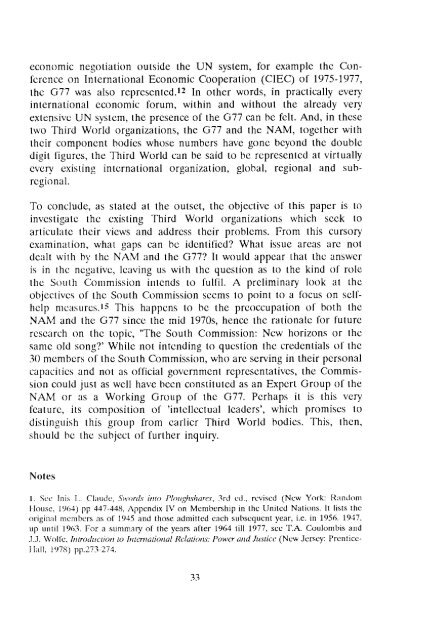ifda dossier 74 - Dag Hammarskjöld Foundation
ifda dossier 74 - Dag Hammarskjöld Foundation
ifda dossier 74 - Dag Hammarskjöld Foundation
Create successful ePaper yourself
Turn your PDF publications into a flip-book with our unique Google optimized e-Paper software.
economic negotiation outside the UN system, for example the Con-<br />
ference on International Economic Cooperation (CIEC) of 1975-1977,<br />
the G77 was also represented.12 In other words, in practically every<br />
international economic forum, within and without the already very<br />
extensive UN system, the presence of the G77 can be felt. And, in these<br />
two Third World organizations, the G77 and the NAM, together with<br />
their component bodies whose numbers have gone beyond the double<br />
digit figures, the Third World can be said to be represented at virtually<br />
every existing international organization, global, regional and sub-<br />
regional.<br />
To conclude, as stated at the outset, the objective of this paper is to<br />
investigate the existing Third World organizations which seek to<br />
articulate their views and address their problems. From this cursory<br />
examination, what gaps can be identified? What issue areas are not<br />
dealt with by the NAM and the G77? It would appear that the answer<br />
is in the negative, leaving us with the question as to the kind of role<br />
the South Commission intends to fulfil. A preliminary look at the<br />
objectives of the South Commission seems to point to a focus on self-<br />
help nieasures.15 This happens to be the preoccupation of both the<br />
NAM and the G77 since the mid 1970s, hence the rationale for future<br />
research on the topic, "The South Commission: New horizons or the<br />
same old song'?' While not intending to question the credentials of the<br />
30 members of the South Commission, who are serving in their personal<br />
capacities and not as official government representatives, the Commis-<br />
sion could just as well have been constituted as an Expert Group of the<br />
NAM or as a Working Group of the G77. Perhaps it is this very<br />
feature, its composition of 'intellectual leaders', which promises to<br />
distinguish this group from earlier Third World bodies. This, then,<br />
should he the subject of further inquiry.<br />
Notes<br />
1. Src Inis I.. CI;iude, Swords into Ploiighsfiares, 3rd cd,, revised (New York: rand on^<br />
House, 1904) pp 447-448. Appendix IV on Membership in the United Nations. It lists the<br />
original members as of 1945 and those admitted each subsequent year, i.e. in 1956. 1947.<br />
up until 1963. For a summary of the years after 1964 till 1977, see T.A. Coulombis and<br />
J.J. Woll'e, Introduction to International Relations: Power atid Justice (New Jersey: I'rentice-<br />
I [;ill, 1078) pp.273-2<strong>74</strong>.
















